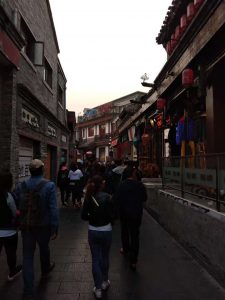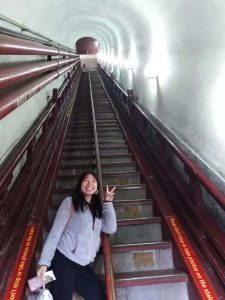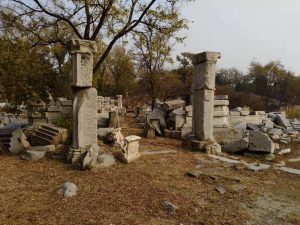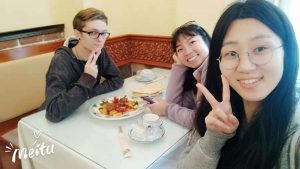As the last warm breaths of the Chinese Summer ceased, the landscape here at Peking University (also called “Beida” (北大) for short) began to change with the seasons. The trees around Beida’s famous Weiming Lake transformed from a vibrant green to a glowing yellow as the century-old koi fish began revealing themselves near the edges of the popular body of water. After seeing Shanghai for the first time, my good friend Ivy, a bright student from American University, and I decided to explore more local and authentic locations in Beijing.
We began our adventures by traveling to some of Beijing’s most famous hutong (胡同) neighbourhoods. Hutong neighbourhoods, which are essentially small alleyways made up of homes and shops (hutong roughly translates to  alley in English), once made up the majority of Beijing’s total area. However, many hutongs have been lost to the construction of things like subway lines, roads, and new apartment buildings. Despite this, many hutongs remain, such as the Nanluoguxiang hutong near the Beijing Bell and Drum towers. Nanluoguxiang was built during the Yuan Dynasty and has endured the last 1,000 or so years. Nanluoguxiang was filled with people, primarily tourists, as well as the smells of truly incredible food. I noticed the famous Beijing Jianbing (a pancake-like dish with eggs) being sold all over the hutong, as well as a disproportionate amount of people speaking the local Beijing dialect of Chinese.
alley in English), once made up the majority of Beijing’s total area. However, many hutongs have been lost to the construction of things like subway lines, roads, and new apartment buildings. Despite this, many hutongs remain, such as the Nanluoguxiang hutong near the Beijing Bell and Drum towers. Nanluoguxiang was built during the Yuan Dynasty and has endured the last 1,000 or so years. Nanluoguxiang was filled with people, primarily tourists, as well as the smells of truly incredible food. I noticed the famous Beijing Jianbing (a pancake-like dish with eggs) being sold all over the hutong, as well as a disproportionate amount of people speaking the local Beijing dialect of Chinese.
After we explored the hutong, Ivy and I climbed the tall steps to the top of the Beijing Gulou (北京鼓樓), or Beijing Drum Tower. In ancient times, bell towers were used in Chinese cities to signal time, much like clock towers in the West, while drum towers were primarily used to signal different events occuring in  the city, usually involving the Emperor or other government or public events. Many Chinese cities still have their drum and bell towers, and of course Beijing is no exception. The bright red tower is truly stunning, and it manages to work itself nicely into the local landscape. The towers stairs have to been the steepest stairs in the world; one tumble down those and I think anyone would be a goner, so climb carefully! After reaching the top, the proceeding view of Beijing is truly stunning. While it was rather polluted the day we went, it was still worth the hike up to the top.
the city, usually involving the Emperor or other government or public events. Many Chinese cities still have their drum and bell towers, and of course Beijing is no exception. The bright red tower is truly stunning, and it manages to work itself nicely into the local landscape. The towers stairs have to been the steepest stairs in the world; one tumble down those and I think anyone would be a goner, so climb carefully! After reaching the top, the proceeding view of Beijing is truly stunning. While it was rather polluted the day we went, it was still worth the hike up to the top.
The two of us also returned to Yuanming Yuan (圓明園) which we had explored together in the end of Summer. Yuanming Yuan, or the Old Summer Palace, is right next to Peking University, making it easy to visit. While the Palace was  gorgeous in the Summer, I almost like it better during the Fall. The yellow colours and dead grass go hand-in-hand with the ruins there.
gorgeous in the Summer, I almost like it better during the Fall. The yellow colours and dead grass go hand-in-hand with the ruins there.
Other than exploring Beijing, I have had great opportunities to get to know my teachers more and more as well as make more friends. After a language exercise at my comprehensive class teacher’
s university, we all had lunch with her and managed to talk and get to know her a bit more. It’s truly an amazing experience to make new friends and get to know people in your second language! Our teachers and us students have really gotten close over the semester, with inside jokes and being made daily. Hardly a day goes by without the class busting out laughing at least once.
So far, Beijing has yet to disappoint. I just hope I can see all there is to see in the time I have, which is already going so fast. The more time I spend here, the  more my behavours and mindset begin to shift towards the Chinese perspective. It makes me wonder what it will be like to return to Linfield in May!
more my behavours and mindset begin to shift towards the Chinese perspective. It makes me wonder what it will be like to return to Linfield in May!


